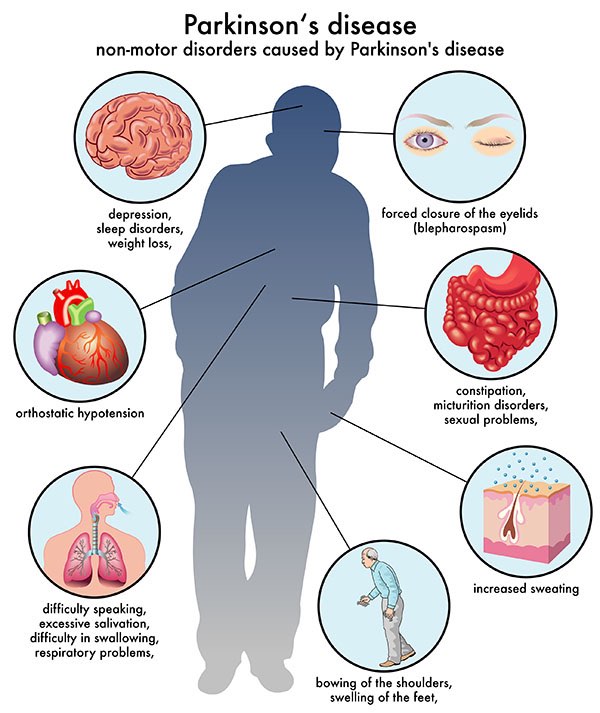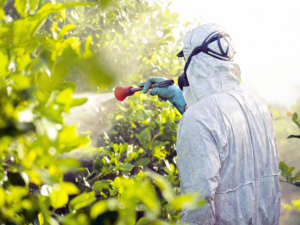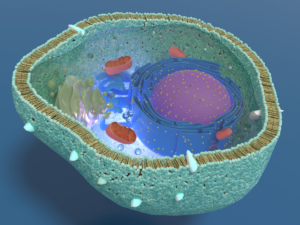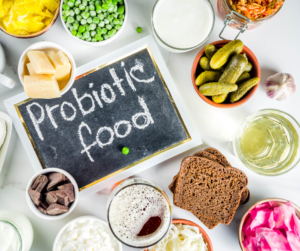By Claire Bacon, ACN, CNC
Parkinson’s disease (PD) is a degenerative disease of the central nervous system. It results from depletion of dopamine-producing cells in the brain. This loss of brain cells likely stems from chronic exposure to environmental chemicals (air pollution and pesticides), but may have a genetic component, as well. In addition, other contributing factors include: oxidative stress, mitochondrial damage, and generalized inflammation.
Prevalence
Up to one million Americans currently live with Parkinson’s disease, with 60,000 new cases being diagnosed each year. Parkinson’s is the second most frequent neurodegenerative disease after Alzheimer’s Disease. Men are twice as likely to be affected than women. The risk increases substantially after age 55; however, one in 20 patients is diagnosed under the age of 40. In women, the disease may be less likely overall, but when it occurs, it advances more quickly and more often can be fatal.
Symptoms
There are two distinct manifestations of Parkinson’s: Motor Symptoms and Non-Motor Symptoms.
Motor symptoms include the typical hand tremors and muscle rigidity that are commonly (but not always) shown with this disease. Painful muscle cramping can also occur, with simple movements like turning over in bed or buttoning a shirt becoming too difficult to bear. Progression of the disease causes movements to become slower and slower, with much hesitancy in small movements like using silverware. There can even be a feeling of “freezing” as if their feet are stuck to the floor. This feeling is temporary and usually subsides in less than a minute.
Non-motor symptoms are those not related to movement. They typically develop much later in the disease progression, but there are exceptions where some people only develop the non-motor symptoms. These could include: incontinence, constipation, difficulty swallowing, inability to control saliva, dizziness, lack of coordination, sleepiness, nightmares, depression, anxiety, and hallucinations. In addition, generalized and severe pain could affect many parts of the body.

Genetics
In approximately 15 percent of cases or less, there is a familial or genetic component. The following genetic SNPs are associated with a higher risk of the disease: SNCA, LRRK2, PARK2, PINK1, PARK7, and ATP13A2. Genetically speaking, some people have a reduced ability to detoxify environmental chemicals, which obviously could increase disease risk. Research into the genetic contributions of the disease are just beginning; additional research and genetic therapy options are likely to increase in the near future.
Primary Causes of Parkinson’s
Conventional medical dogma holds tightly to the notion that Parkinson’s has no known cause. However, the scientific research shows this is not true. We now know there are several clear triggers responsible for the majority of cases:
- Air pollution
- Pesticides such as Glyphosate and Paraquat
- Drycleaning chemicals (TCE and PCE)
- Oxidative stress
- Mitochondrial damage
- Inflammation from other environmental toxins
Air Pollution
Radon is a noble, colorless, odorless, and tasteless gas. It is soluble in lipids and can accumulate in body fat-rich tissues such as the brain. Because radon may be absorbed into the brain, it is a possible cause of neuro-degenerative diseases such as Parkinson’s. When an individual inhales ambient air with radon, some of the radon that may get trapped in the lungs goes into the circulatory system, where it could get carried to the brain. Studies are unclear whether there is true causation.
Mold and fungus may play a part in causing Parkinson’s-like symptoms. Researcher Joan Bennett of Rutgers performed an interesting study, exposing fruit flies to fungus samples taken from her home. She found that the mold caused the flies to experience movement disorders, and they suffered reduced dopamine levels and dopamine neuron degeneration.
Exhaust fumes from diesel engines can trigger the toxic buildup of a protein in the brain called alpha-synuclein, which is commonly seen in people with Parkinson’s. One way this protein can build up is through the disruption of “autophagy”—the process of breaking down old or damaged proteins. A healthy brain continuously makes and disposes of the proteins it needs for communication between neurons, but when this disposal process stops working, the cells continue to make new proteins and the old ones never get cleared away.
A study from the Barrow Neurological Institute shows that people living in high-traffic areas (with high air pollution) tend to have higher rates of Parkinson’s. The Mississippi-Ohio River Valley was identified as a Parkinson’s disease hotspot, along with central North Dakota, parts of Texas, Kansas, eastern Michigan, and the tip of Florida. People living in the western half of the U.S. are at a reduced risk of developing Parkinson’s disease compared with the rest of the nation.

Pesticides
Pesticides seem to accumulate in the dopaminergic tract, where they inhibit mitochondrial function and lead to neuronal death. Dopaminergic neurons are particularly susceptible to the pesticide Dieldrin, which is no longer in use in the U.S. but is still present on conventional farmland from its use years ago. Some pesticides also impair the breakdown of protein aggregates, like Lewy bodies.
Research has found that exposure to the pesticide Paraquat greatly increases the risk of developing Parkinson’s, and ongoing exposure can damage brain cells and lead to kidney, heart, and liver failure, as well as lung scarring and pulmonary edema. It is banned in more than 50 countries around the world, but is still allowed for use in the U.S.
Another pesticide, Rotenone, was noted to be harmful by the NIH. “Rotenone directly inhibits the function of the mitochondria, the structure responsible for making energy in the cell,” said Freya Kamel, Ph.D., a researcher in the intramural program at NIEHS and co-author of the paper appearing online in the journal Environmental Health Perspectives.
There are no home garden or residential uses for either Paraquat or Rotenone currently registered. Paraquat use has long been restricted to certified applicators, largely due to concerns based on studies of animal models of Parkinson’s disease. Use of rotenone as a pesticide to kill invasive fish species is currently the only allowable use of this pesticide.

Drycleaning chemicals (TCE and PCE)
Trichloroethylene (TCE) is a degreasing chemical that is known to cause cancer. I, myself, used it regularly in my first engineering internship with the South Carolina DOT in 1993. I always used gloves, but the old guys would literally wash their hands with it to clean up after a project. Of course, we knew it was dangerous stuff back then, but the old timers didn’t care!
It is distressing to learn in how many ways Trichloroethylene may have touched our lives. It was used in decaffeinated Sanka coffee in the 1970s, also in typewriter correction fluid, and it was used in many industrial applications to degrease metals. TCE is currently still being used in drycleaning fluids and in the semiconductor industry. However, in a turn of good news, the EPA just recently proposed a ban on TCE, which if passed, would go into effect in 2025. A TCE contamination map can be found here.
Perchloroethylene (PCE or PERC) is TCE’s cousin. It is commonly used in drycleaning fluids and as a solvent that Electricians and Artists may often use. In addition, it is present in many adhesives (arts and crafts, as well as light repairs), aerosol degreasers, brake cleaners, aerosol lubricants, sealants, stone polish, stainless steel polish, and wipe cleaners. Furthermore, inhalation exposures may occur due to volatilization of perchloroethylene from contaminated water (municipal or well water) during showering and bathing.

Oxidative Stress
Oxidative stress is a state of imbalance between the levels of reactive oxygen species (ROS) produced vs. the ability to quench them. In the brain, ROS (or oxidative stress) causes degeneration of the dopamine-producing neurons. This reduces the “redox potential”, which interferes with normal brain functions, ultimately leading to cell death. Other brain conditions such as Alzheimer’s, Huntington’s, and Amyotrophic Lateral Sclerosis (ALS) are associated with oxidative stress. This suggests that oxidative stress is a common mechanism contributing to neuronal degeneration. Although, it can manifest with differing outcomes.
Mitochondrial Damage
Our brain is a huge energy consumer. It is only 3% of our body’s weight but consumes 20% of our energy, ATP, and blood glucose. Brain neurons are full of tiny little furnaces called mitochondria. They are responsible for much of the brain activity that controls our speech, memory, and movements. However, our protective blood-brain barrier can become compromised. If so, this allows toxic chemicals to enter and down-regulate the neurons and mitochondria in the brain.
Mitochondrial injury results in less ATP generation, loss of cellular repair mechanisms, and cellular inefficiency. As the little furnaces become dysfunctional they generate more free radicals, which increases oxidative stress and inflammation throughout the body. With fewer mitochondria available, this reduces energy. It impacts how you feel and what you do. And it hurts your ability to think clearly and operate your body in a normal manner.

Inflammation
Inflammation occurs within the body for a wide variety of reasons. These could be toxins, infections, ROS, and lack of nutrients. With regards to Parkinson’s, inflammation affects the microglia cells (immune cells in the brain). When activated, the microglia cells release inflammatory cytokines. These are chemical messengers that bind to healthy neurons and cause degeneration. The most significant cytokine is tumor necrosis factor-alpha (TNF-α). You can test for it in the blood, although this is not a common marker to watch.
Secondary Causes of Parkinson’s
Other forms of Parkinson’s symptoms can occur as a secondary effect of something else. These might include:
- a brain tumor,
- medications,
- carbon monoxide poisoning,
- viral encephalitis,
- other chronic infections,
- or sleeping sickness.
In addition, repeated head trauma can damage the dopaminergic cells within the midbrain. This often happens with athletes playing professional sports. These causes can lead to the same apparent symptoms listed in the Primary discussion, above.
For example, the influenza pandemic of 1917 caused encephalitis in people worldwide. Years later, a high percentage of these same patients developed Parkinson’s. It was as if the “seeds” to the disease had been planted with the initial inflammation of the brain. We also know that the chronic immune dysregulation of AIDS may eventually lead to Parkinson’s. And any injury that results in lack of oxygen to the brain can be a contributing factor, as well.
Best Prevention Strategies
Exercise
Exercise is one of the best ways to prevent or reduce the effects of Parkinson’s symptoms. Exercises that encourage balance and coordination can actually slow progression of the disease. Examples would be jogging on a treadmill, stationary cycling, or elliptical training. You could even dance! Yoga and strength training also have good benefits. The more strenuous the activity, the better. Vigorous cardiovascular exercise helps the brain maintain neuroplasticity. That’s the ability to maintain old connections and form new ones between the neurons in the brain.
Remember – exercising makes you sweat! And exercise increases circulation to the brain! It’s the best way you can stimulate natural detoxification, a good mood, and strengthening – all in one!

Eating Organic
Do we need another reason to go organic? Apparently so. Pesticides and herbicides are heavily implicated in causing Parkinson’s. These chemicals exist in the brains of Parkinson’s sufferers, in excess when compared to those with regular dopamine levels. A quick Google search easily turns up news of lawsuits against pesticide manufacturers. We know that organic foods are not perfect and can sometimes have contamination, too. However, organic is our best bet for avoiding the synthetic chemicals that can make us sick.
Some specific foods are healthier than others. Because Folic Acid can be beneficial for detox, we want to consume natural sources. Good examples are broccoli, kale, spinach, collard greens, Brussels sprouts, asparagus and okra. These should rotate regularly through your diet.
Everything you can do to eat an anti-inflammatory diet will be worth your while. For instance, Omega 3 fatty acids combined with Turmeric root would be a powerhouse of anti-inflammatory action. Wild caught salmon with a gingery-turmeric sauce and the greens listed above would be a perfect dinner.
EGCG from Green Tea has protective benefits on the neural network of the brain. Green tea is good for microcirculation, and supports dopamine levels in ailing brain tissue. When shopping for green tea, choose a higher quality and organic brand. Some of the lower quality brands may contain fluoride – a known neurotoxin. Even if you’re not crazy about the taste, you can easily cover it up. It’s easy to mix a teaspoon or two of Matcha green tea into your smoothies. You’ll never know the difference!

Promoting the Gut Microbiome
If you’ve been paying attention, you’ll know we have Brain #1 (head) and Brain #2 (gut). Within both the head and the gut, we have a “microbiome”. It’s the living jungle of microorganisms that do so much beneficial work for us. Our good bacteria produce neurotransmitters, they break down and absorb our food, and they remove heavy metals and toxins.
So, whatever you do – keep an eye out for your microbial life. You need to eat fermented foods, take a probiotic, eat more fiber, and maybed do a stool analysis. Research shows a high-fiber, whole food, plant-fueled diet, with Mediterranean-style fruits and veg are best. This style of eating can increase short-chain fatty acids and your beneficial bacteria. You take care of them, and they will take care of you!
Please note that “Mediterranean diet” does not mean cookies, chips, cereal, or other processed foods!

Detoxification
For a condition caused by excess toxicity, the best first step is to detoxify (aka get the bad chemicals out). Unfortunately, the deepest forms of chemical detoxification have not been successful for reducing symptoms in Parkinson’s. A gentler, more natural approach must be taken. It’s better to use naturally cleansing herbs and foods. The harsh chelators and IV procedures really aren’t worth it.
Helpful Supplements:
As always, we have some good supplements for you! The hard part is deciding whether or not to take all of them!
CoQ10
CoQ-Zyme-100 Plus provides bioavailable CoQ10, which is an antioxidant used by the mitochondria. Within your cells, the mitochondria produce energy for cell growth and maintenance. The mitochondria use CoQ10 to protect cells from damage. Our cells are under constant assault from free radicals from pesticides and other chemical exposures.
Creatine
Creatine is an amino acid-like compound that is well-known in the muscle-building world. It is included here for its role in cellular energy management. Taking creatine promotes the mitochondria, and is neuro-protective in a wide range of neurological diseases.
Omega 3s
Omega 3 fatty acids, as discussed above, are vital for maintaining our cellular membranes. We know that Omega 3s are obtained chiefly from fish. Our favorite is Cod Liver Oil. It is also found to a lesser extent in walnuts and flax seed oil. Consuming Omega 3 fish oils is the primary way we can reduce systemic inflammation. It works anywhere throughout the body and supports a healthy brain.
B Vitamins
B vitamin deficiencies can contribute to neurological conditions, especially folate and vitamin B12. These two are cofactors that are necessary in multiple biological processes. We often recommend Methylfolate Plus or 5-MTHF Plus Forte as good sources of these nutrients.
Vitamin D
Vitamin D receptors are expressed throughout the body, including the microglial cells in the brain. The Vitamin D receptors signal for the expression of multiple immune-modulating genes. Higher Vitamin D status is protective against the onset of Parkinson’s symptoms. If you can’t get good sunshine on a regular basis, a Vitamin D3 supplement is essential. We recommend taking D3 with Vitamin K to enhance absorption and protect the blood vessels. K-Force is our current favorite that we carry in the office.
Carnitine
Acetyl L-Carnitine is a vital cofactor in fatty acid metabolism. We can find it naturally occurring in meat. It helps to ferry large fat molecules into the mitochondrial furnaces, where they are burned for energy. Carnitine plays an important part in brain energy management, by promoting synthesis of acetylcholine. It is available in capsule or powder form through our Biotics web store.
Resveratrol
Resveratrol is a polyphenolic antioxidant compound that potentially could prevent cardiovascular disease and enhancing longevity. It has a multi-modal mechanism of action targeting oxidative stress, inflammation, and sirtuins (that are involved in regulating mitochondrial activity). Resveratrol is naturally present in Japanese Knotweed herb (in HerbaVital) and can be used in higher doses in ResveraSirt-HP.
PQQ
Pyrroloquinoline quinone (PQQ) is a highly bioactive compound. It improves mitochondrial function, inhibits oxidative stress, and supports neurological health. It appears to stimulate cerebral blood flow and oxygen use.
Curcumin
Turmeric/Curcumin is a natural inhibitor of inflammation, through its potent modulation of the NF-kappa B system. It prevents chemically-induced changes in lab models of Parkinson’s and exerts significant neuro-protection. Our best choice is Mediherb Turmeric Forte.

Other promising supplements include:
- Melatonin – this antioxidant hormone from the pineal gland may help to reduce the accumulation of alpha-synuclein proteins, while preserving the cell’s ability to make dopamine. Also helps with sleep.
- N-Acetyl Cysteine (NAC) – is a precursor to our master antioxidant, glutathione. NAC can prevent dopamine-induced neurotoxicity and can protect against some of the damaging effects from alpha-synuclein proteins.
- Lipoic Acid – is an antioxidant that helps with xenobiotic detoxification and cellular energy production. Helps to neutralize toxins and free radicals, and supports glutathione production.
- Green Coffee Bean extract,
- Probiotics with a wide variety of strains can be beneficial for neurotransmitter production, help to mediate the influence of pesticides, and also may relieve constipation.
- Mucuna pruriens, which has gained attention but must be considered carefully, and
- Glutathione – our master antioxidant helps to remove a wide range of toxins and protects cells from free radical damage.
Obviously, we have a long way to go to find definitive solutions for this terrible disease. It’s hard to know how to best detoxify pesticides after so many years of consumption. But, with a multi-pronged approach of avoiding toxicity and promoting sufficiency, surely we can improve quality of life for the vast majority of our affected loved ones.
Like this article??
Check out a few more related articles…


